The Vibration Sensor Market is estimated to be valued at USD 7.0 billion in 2025 and is projected to reach USD 14.1 billion by 2035, registering a compound annual growth rate (CAGR) of 7.3% over the forecast period.
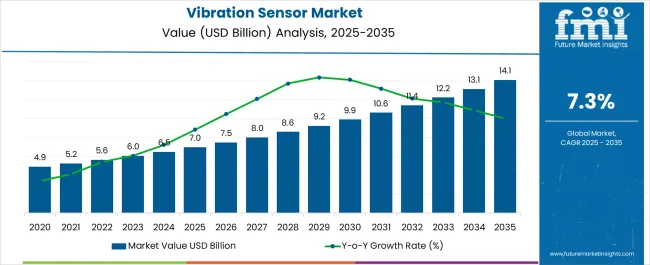
| Metric | Value |
|---|---|
| Vibration Sensor Market Estimated Value in (2025 E) | USD 7.0 billion |
| Vibration Sensor Market Forecast Value in (2035 F) | USD 14.1 billion |
| Forecast CAGR (2025 to 2035) | 7.3% |
The vibration sensor market is experiencing consistent expansion, supported by the growing focus on predictive maintenance, structural health monitoring, and industrial automation. Demand is being reinforced by the critical role these sensors play in ensuring operational efficiency, equipment longevity, and worker safety across diverse industries. Advancements in sensor miniaturization, digital signal processing, and wireless connectivity are enabling integration into next-generation industrial systems and smart infrastructure.
Rising awareness about reducing unplanned downtime and optimizing asset utilization is further driving adoption across manufacturing, aerospace, automotive, and energy sectors. Governments and regulatory agencies are increasingly emphasizing compliance with safety standards, which is compelling industries to deploy reliable sensing technologies for continuous monitoring.
In addition, the growing transition toward Industry 4.0 and the Industrial Internet of Things is expanding opportunities for advanced vibration sensors with real-time data analytics capabilities As industries increasingly invest in automation and smart monitoring systems, the market is positioned for strong growth, with continuous innovation in sensor technology and predictive analytics reinforcing its long-term trajectory.
The vibration sensor market is segmented by application, type, and geographic regions. By application, vibration sensor market is divided into Machine & Structure Monitoring, Automobile, Aerospace, Consumer Electronics, Coal & Quarry Sector, Oil & Gas, Medical & Pharmaceuticals, and Others. In terms of type, vibration sensor market is classified into Accelerometers, Velocity Sensor, and Displacement Sensor. Regionally, the vibration sensor industry is classified into North America, Latin America, Western Europe, Eastern Europe, Balkan & Baltic Countries, Russia & Belarus, Central Asia, East Asia, South Asia & Pacific, and the Middle East & Africa.
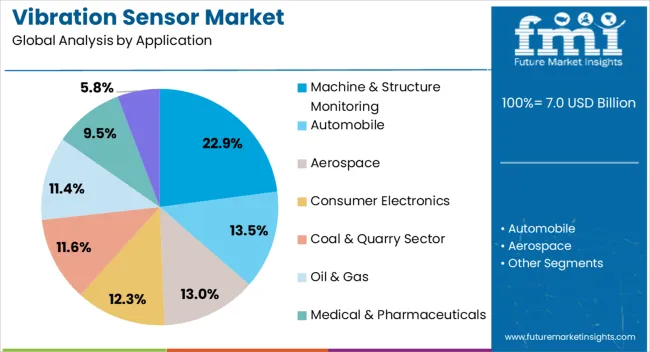
The machine and structure monitoring application segment is projected to account for 22.9% of the vibration sensor market revenue share in 2025, making it the leading application category. This dominance is being supported by the rising demand for predictive maintenance and condition monitoring in industries where equipment reliability is critical. Continuous monitoring of machinery and structural integrity helps prevent unexpected failures, reducing costly downtime and enhancing operational safety.
Adoption is being accelerated by industries such as energy, automotive, aerospace, and heavy manufacturing, where asset optimization and lifecycle management have become strategic priorities. The increasing integration of sensors into advanced monitoring platforms allows real-time data collection and analysis, enabling predictive insights that improve efficiency and productivity.
In addition, growing regulatory focus on workplace safety and compliance is compelling organizations to invest in robust monitoring solutions With the need to ensure consistent performance of critical infrastructure and industrial machinery, the machine and structure monitoring segment is expected to retain its leading position, supported by its ability to deliver measurable improvements in efficiency, safety, and cost reduction.
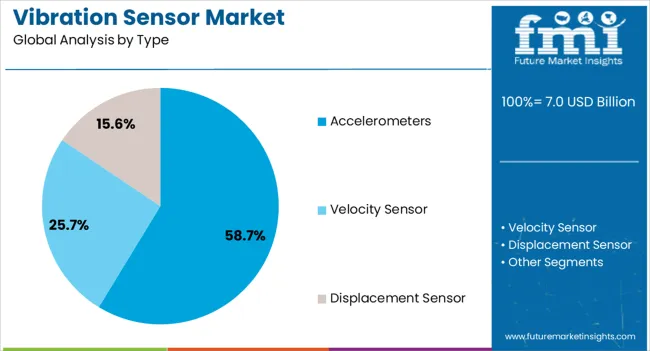
The accelerometers segment is expected to represent 58.7% of the vibration sensor market revenue share in 2025, making it the dominant type. This leadership is being driven by the segment’s ability to provide high sensitivity, accuracy, and reliability in measuring vibration across a wide range of applications. Accelerometers are increasingly adopted in predictive maintenance systems, structural monitoring, and automotive safety technologies due to their proven performance in detecting minute vibration changes.
Their compatibility with both wired and wireless communication networks is supporting integration into advanced industrial automation systems and IoT-enabled platforms. The segment is also benefiting from advancements in MEMS technology, which allow the development of compact, cost-effective, and energy-efficient accelerometers suited for large-scale deployment.
Widespread adoption is further being supported by their critical role in aerospace and defense, automotive crash testing, and energy sector equipment monitoring As industries continue to demand real-time data for decision-making and efficiency improvements, accelerometers are expected to maintain their dominant share, reinforced by continuous innovation in design and manufacturing that enhances precision, durability, and application versatility.
Vibration sensor can also be termed as vibration transducer that converts vibrations into an electrical equivalent output (such as voltage). Vibration means any motion of object from its mean position. It can be caused due to number of reasons such as external excitation, unbalanced centrifugal force, friction between surface and wind.
Vibration has various advantages as well as disadvantages. It is used to detect any catastrophic events and to take preventive measures. However, in industrial and commercial sector this vibration is undesirable as it causes damage to machines. Furthermore, excess damage is also unsafe for human beings.
Hence, to avoid this dangerous situation vibration level should be measured with the help of vibration sensor.
The global vibration sensor market is expected to witness significant growth over the period of forecast. Factors which are driving the growth of global vibration sensor market are wide range of frequency, self-generating capability and long service life.
Furthermore, rapid improvement and customization options are few additional drivers of global vibration sensor market.
On the other hand, major factor hindering the growth of global vibration sensor market is maturity of end-user segment
On the basis of application, the global vibration sensor market can be segmented into automobile, aerospace, consumer electronics, coal & quarry sector, oil & gas, machine & structure monitoring, medical & pharmaceuticals and others.
The global vibration sensor market growth is accelerated because of high adoption of vibration sensors in aerospace industry. Furthermore, vibration sensors are used in wide areas such as vibration in shock treatment, breathing monitoring, measuring machine vibrations and other applications. Vibration sensors are also used in digital displays and touch screens.
On the basis of region, the global vibration sensor market can be seven regions which include – North America, Latin America, Asia-Pacific excluding Japan (APEJ), Western Europe, Eastern Europe, Japan and Middle East & Africa.
North America is dominating the global vibration sensor market and expected to remain dominant throughout the forecast period. However, Asia Pacific is expected to expand at highest compound annual growth rate over the forecast period.
The report is a compilation of first-hand information, qualitative and quantitative assessment by industry analysts, inputs from industry experts and industry participants across the value chain. The report provides in-depth analysis of parent market trends, macro-economic indicators and governing factors along with market attractiveness as per segments. The report also maps the qualitative impact of various market factors on market segments and geographies.
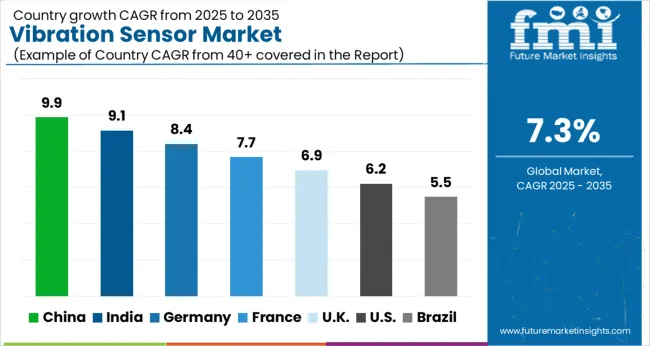
| Country | CAGR |
|---|---|
| China | 9.9% |
| India | 9.1% |
| Germany | 8.4% |
| France | 7.7% |
| UK | 6.9% |
| USA | 6.2% |
| Brazil | 5.5% |
The Vibration Sensor Market is expected to register a CAGR of 7.3% during the forecast period, exhibiting varied country level momentum. China leads with the highest CAGR of 9.9%, followed by India at 9.1%. Developed markets such as Germany, France, and the UK continue to expand steadily, while the USA is likely to grow at consistent rates. Brazil posts the lowest CAGR at 5.5%, yet still underscores a broadly positive trajectory for the global Vibration Sensor Market. In 2024, Germany held a dominant revenue in the Western Europe market and is expected to grow with a CAGR of 8.4%. The USA Vibration Sensor Market is estimated to be valued at USD 2.4 billion in 2025 and is anticipated to reach a valuation of USD 4.3 billion by 2035. Sales are projected to rise at a CAGR of 6.2% over the forecast period between 2025 and 2035. While Japan and South Korea markets are estimated to be valued at USD 335.1 million and USD 184.2 million respectively in 2025.
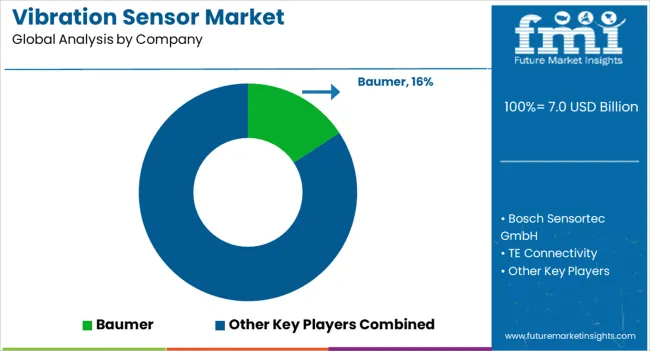
| Item | Value |
|---|---|
| Quantitative Units | USD 7.0 Billion |
| Application | Machine & Structure Monitoring, Automobile, Aerospace, Consumer Electronics, Coal & Quarry Sector, Oil & Gas, Medical & Pharmaceuticals, and Others |
| Type | Accelerometers, Velocity Sensor, and Displacement Sensor |
| Regions Covered | North America, Europe, Asia-Pacific, Latin America, Middle East & Africa |
| Country Covered | United States, Canada, Germany, France, United Kingdom, China, Japan, India, Brazil, South Africa |
| Key Companies Profiled | Baumer, Bosch Sensortec GmbH, TE Connectivity, NATIONAL INSTRUMENTS CORP, Honeywell International Inc., SAFRAN, Hansford Sensors, DYTRAN INSTRUMENTS INCORPORATED, Analog Devices, Inc., and ASC GmbH |
The global vibration sensor market is estimated to be valued at USD 7.0 billion in 2025.
The market size for the vibration sensor market is projected to reach USD 14.1 billion by 2035.
The vibration sensor market is expected to grow at a 7.3% CAGR between 2025 and 2035.
The key product types in vibration sensor market are machine & structure monitoring, automobile, aerospace, consumer electronics, coal & quarry sector, oil & gas, medical & pharmaceuticals and others.
In terms of type, accelerometers segment to command 58.7% share in the vibration sensor market in 2025.






Our Research Products

The "Full Research Suite" delivers actionable market intel, deep dives on markets or technologies, so clients act faster, cut risk, and unlock growth.

The Leaderboard benchmarks and ranks top vendors, classifying them as Established Leaders, Leading Challengers, or Disruptors & Challengers.

Locates where complements amplify value and substitutes erode it, forecasting net impact by horizon

We deliver granular, decision-grade intel: market sizing, 5-year forecasts, pricing, adoption, usage, revenue, and operational KPIs—plus competitor tracking, regulation, and value chains—across 60 countries broadly.

Spot the shifts before they hit your P&L. We track inflection points, adoption curves, pricing moves, and ecosystem plays to show where demand is heading, why it is changing, and what to do next across high-growth markets and disruptive tech

Real-time reads of user behavior. We track shifting priorities, perceptions of today’s and next-gen services, and provider experience, then pace how fast tech moves from trial to adoption, blending buyer, consumer, and channel inputs with social signals (#WhySwitch, #UX).

Partner with our analyst team to build a custom report designed around your business priorities. From analysing market trends to assessing competitors or crafting bespoke datasets, we tailor insights to your needs.
Supplier Intelligence
Discovery & Profiling
Capacity & Footprint
Performance & Risk
Compliance & Governance
Commercial Readiness
Who Supplies Whom
Scorecards & Shortlists
Playbooks & Docs
Category Intelligence
Definition & Scope
Demand & Use Cases
Cost Drivers
Market Structure
Supply Chain Map
Trade & Policy
Operating Norms
Deliverables
Buyer Intelligence
Account Basics
Spend & Scope
Procurement Model
Vendor Requirements
Terms & Policies
Entry Strategy
Pain Points & Triggers
Outputs
Pricing Analysis
Benchmarks
Trends
Should-Cost
Indexation
Landed Cost
Commercial Terms
Deliverables
Brand Analysis
Positioning & Value Prop
Share & Presence
Customer Evidence
Go-to-Market
Digital & Reputation
Compliance & Trust
KPIs & Gaps
Outputs
Full Research Suite comprises of:
Market outlook & trends analysis
Interviews & case studies
Strategic recommendations
Vendor profiles & capabilities analysis
5-year forecasts
8 regions and 60+ country-level data splits
Market segment data splits
12 months of continuous data updates
DELIVERED AS:
PDF EXCEL ONLINE
Vibration Screening Machine Market Size and Share Forecast Outlook 2025 to 2035
Vibration Damping Levelling Feet Market Size and Share Forecast Outlook 2025 to 2035
Vibration Fiber Optic Perimeter Alarm System Market Size and Share Forecast Outlook 2025 to 2035
Vibration Monitoring Market Size and Share Forecast Outlook 2025 to 2035
Vibration Isolation System industry Analysis in India - Size, Share, and Forecast Outlook 2025 to 2035
Vibration Analyzer Market Growth – Trends & Forecast 2025-2035
Vibration Level Switch Market Analysis by Technology, Industry, Application, and Region through 2035
Vibration Control Systems Market Growth - Trends & Forecast 2025 to 2035
Low Vibration Thermostat Market Size and Share Forecast Outlook 2025 to 2035
Anti-Vibration Mounts Market
Tower Vibration Control System Market Size and Share Forecast Outlook 2025 to 2035
Noise Vibration Harshness (NVH) Testing Market
Noise And Vibration Coatings Market Size and Share Forecast Outlook 2025 to 2035
Bonding Honeycomb Vibration Isolation Platform Market Size and Share Forecast Outlook 2025 to 2035
Sensor Data Analytics Market Size and Share Forecast Outlook 2025 to 2035
Sensor Testing Market Forecast Outlook 2025 to 2035
Sensor Fusion Market Size and Share Forecast Outlook 2025 to 2035
Sensor Based Glucose Measuring Systems Market Size and Share Forecast Outlook 2025 to 2035
Sensor Development Kit Market Size and Share Forecast Outlook 2025 to 2035
Sensory Modifier Market Size and Share Forecast Outlook 2025 to 2035

Thank you!
You will receive an email from our Business Development Manager. Please be sure to check your SPAM/JUNK folder too.
Chat With
MaRIA